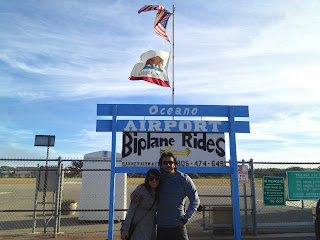Emilio and Tina had been in the possession of not even the smallest smidgeon of luck when it came to aviation. They'd been clouded out, winded out and this time around the plane had too much gas to take the four of us up.
We weren't going to let that stop us. We decided to fly to Santa Ynez and back without Melch for the experience of it. The round-trip having consumed some fuel, we would have the ability to lift off with Melch in the plane and head on to our original destination, L52 (Oceano).
 |
| First rule of aviation: headsets are optional, but sunglasses are mandatory |
 |
| Tina also knows the first rule of aviation. |
 |
| Where UCSB goes to surf instead of study. |
I assume that it can all be blamed on the fact that I'm just a giant noob who still has a lot of learning to do. All whining aside though, we made it safe and sound and enjoyed a lunch at the Rock and Roll Diner.
 |
| Some good looking wind down the runway |
The return flight was more eventful. The cloud cover had come in and my transponder had stopped working. Planes use transponders to send data to controllers. If you don't have a transponder, you're just a dot on a radar scope. With your transponder on? You're a dot with a tail number, an altitude and an aircraft type.
Controllers like transponders because they make their job easier. You don't have to have one generally, but busier airports require them. Notably, Santa Barbara Airport requires one. I worked with the controller, cycling the transponder and trying different codes, but the transponder was not working.
I received special permission to enter SBA's class C airspace with the inop transponder. For me, this required extra radio work as I had to identify my situation and altitude at every handoff. I'm sure it was some more work for the controllers as well, but the airport was pretty quiet at the time and everything proceeded smoothly.
Oceano was clear and Santa Barbara was clear, but the cloud cover had expanded substantially during our lunch. I requested a higher altitude from Santa Barbara Approach to maintain my legal cloud clearance requirements. Even so, I kept to the edge of the clouds wherever possible as it's always safer to be able to see the ground in case of emergency.
 |
| Clouds might cause some headache, but they sure are beautiful |
 |
| Although we didn't do this trip in 37G, I have a soft spot in my heart for her |
No comments:
Post a Comment